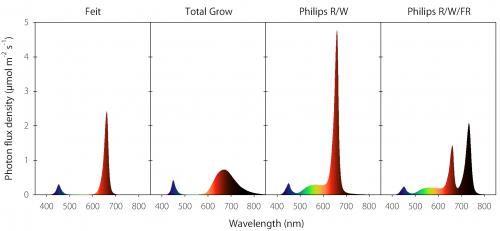By Qingwu Meng, and Erik Runkle
Many ornamental plants flower when their biological clock is in sync with day length. Short-day and long-day plants, as their names indicate, flower most rapidly under short and long days, respectively. During natural short days, lighting at night can delay flowering of short-day plants to stimulate vegetative growth, or promote flowering of long-day plants. Most incandescent light bulbs have been phased out because of their energy inefficiency. Compact fluorescent lamps have higher luminous efficacy, but are not as effective as incandescent lamps for some long-day plants. What’s a suitable alternative, then?
Numerous light-emitting diode (LED) lamps have been developed for horticulture applications during the past several years. However, not all LEDs are created equal; for example, some are better than others at regulating flowering. Research performed at Michigan State University has shown that the light spectrum is key to regulating flowering. A spectrum rich in red light (600 to 700 nm) is capable of inhibiting flowering of short-day plants. The inclusion of far red (700 to 800 nm) with red light can sometimes accelerate flowering of long-day plants. At the low light intensity typically delivered (≈2 µmol·m−2·s−1), blue and green light are less or not effective at regulating flowering.
Photo 1. Photos of some screw-in LEDs developed for horticulture applications showing the lamp and the color of light emitted. Photo: Qingwu Meng, MSU.
We measured the light emitted from four types of LED screw-in lamps that greenhouse growers in Michigan have been using in their facilities. These are the Feit Electric Plant Grow Light (BR30/11K/GROW/LED), Total Grow Night and Day Management Light (TG1A-1004) and two Philips GreenPower LED Flowering Lamps (DR/W and DR/W/FR) (Photo 1). We measured light output 8 inches (20 centimeters) directly below the lamps using a portable spectroradiometer, which is a device that measures light intensity at different wavelengths. As expected, the LEDs had distinctly different spectra and intensities (Photo 2). The Feit lamp emitted predominantly red light (87 percent) while the Total Grow lamp had red (60 percent) and far red (27 percent). The Philips R/W lamp produced primarily red light (78 percent) while the Philips R/W/FR lamp generated red (35 percent) and far red (46 percent).

Photo 2. Four commercial light-emitting diode (LED) lamps developed to regulate flowering of day length-sensitive crops differ in their emission spectrum and intensity.
Which of these LEDs to choose depends on several factors including what crops are grown and when. For short-day plants like chrysanthemum, all of these lamps should be effective at inhibiting flowering since they all emit red light. While the presence of red light is sufficient to promote flowering of some long-day plants, other long-day plants, such as snapdragon and petunia, need far red for the most rapid flowering, especially when grown during periods of low light. Therefore, the Total Grow and Philips R/W/FR lamps, which emit red and far red, are most suitable for long-day plants. Aside from the spectrum, growers should also consider durability, cost, light output and uniformity, life time and warranty.
Finally, don’t confuse these “flowering” lamps with supplemental lighting. To regulate flowering, only a very low intensity (1 to 2 µmol·m−2·s−1) is needed, which is what these lamps deliver. To increase growth (faster rooting, thicker stems, etc.), a much higher intensity is needed, and typically 40 to 60 µmol·m−2·s−1 is appropriate for ornamentals. The lamps we tested are suitable to extend the day or interrupt the night to regulate flowering, but provide no benefit when turned on during the day. Visit the MSU Floriculture webpage for more information on horticultural lighting.